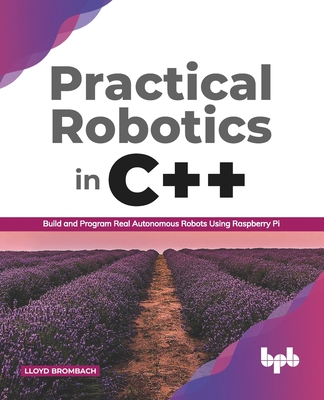Practical Robotics in C++: Build and Program Real Autonomous Robots Using Raspberry Pi (Paperback)
暫譯: C++ 實用機器人技術:使用 Raspberry Pi 構建和編程真正的自主機器人 (平裝本)
Brombach, Lloyd
- 出版商: Bpb Publications
- 出版日期: 2021-01-29
- 售價: $1,500
- 貴賓價: 9.5 折 $1,425
- 語言: 英文
- 頁數: 506
- 裝訂: Quality Paper - also called trade paper
- ISBN: 9389423465
- ISBN-13: 9789389423464
-
相關分類:
C++ 程式語言、Raspberry Pi、機器人製作 Robots
-
相關翻譯:
C++ 樹莓派機器人開發實戰指南 (簡中版)
立即出貨 (庫存=1)
買這商品的人也買了...
-
 無瑕的程式碼-敏捷軟體開發技巧守則 (Clean Code: A Handbook of Agile Software Craftsmanship)
無瑕的程式碼-敏捷軟體開發技巧守則 (Clean Code: A Handbook of Agile Software Craftsmanship)$580$452 -
 你所不知道的 JS|範疇與 Closures,this 與物件原型 (You Don't Know JS: this & Object Prototypes)
你所不知道的 JS|範疇與 Closures,this 與物件原型 (You Don't Know JS: this & Object Prototypes)$520$411 -
 你所不知道的 JS|非同步處理與效能 (You Don't Know JS: Async & Performance)
你所不知道的 JS|非同步處理與效能 (You Don't Know JS: Async & Performance)$520$411 -
 你所不知道的 JS|ES6 與未來發展 (You Don't Know JS: ES6 & Beyond)
你所不知道的 JS|ES6 與未來發展 (You Don't Know JS: ES6 & Beyond)$520$411 -
 Soft Robots: Paper, Silicone, Cloth, and Rubber Bots for All Ages
Soft Robots: Paper, Silicone, Cloth, and Rubber Bots for All Ages$950$903 -
 忍者:JavaScript 開發技巧探秘, 2/e (Secrets of the JavaScript Ninja, 2/e)
忍者:JavaScript 開發技巧探秘, 2/e (Secrets of the JavaScript Ninja, 2/e)$650$507 -
 React Native 學習手冊, 2/e (Learning React Native: Building Native Mobile Apps with JavaScript, 2/e)
React Native 學習手冊, 2/e (Learning React Native: Building Native Mobile Apps with JavaScript, 2/e)$580$458 -
 CSS 大全, 4/e (CSS: The Definitive Guide: Visual Presentation for the Web, 4/e)
CSS 大全, 4/e (CSS: The Definitive Guide: Visual Presentation for the Web, 4/e)$1,200$948 -
 $709微服務架構設計模式 (Microservices Patterns: With examples in Java)
$709微服務架構設計模式 (Microservices Patterns: With examples in Java) -
 Python 自動化的樂趣|搞定重複瑣碎&單調無聊的工作, 2/e (Automate the Boring Stuff with Python : Practical Programming for Total Beginners, 2/e)
Python 自動化的樂趣|搞定重複瑣碎&單調無聊的工作, 2/e (Automate the Boring Stuff with Python : Practical Programming for Total Beginners, 2/e)$680$537 -
 機器人 SLAM 導航:核心技術與實戰
機器人 SLAM 導航:核心技術與實戰$894$849 -
 Make: Volume 79: 2022 Guide to Boards
Make: Volume 79: 2022 Guide to Boards$800$760 -
 FLL + WRO 樂高機器人競賽教程 — 機械、巡線與 PID
FLL + WRO 樂高機器人競賽教程 — 機械、巡線與 PID$594$564
商品描述
Learn how to build and program real autonomous robots
Key Features
- Simplified coverage on fundamentals of building a robot platform.
- Learn to program Raspberry Pi for interacting with hardware.
- Cutting-edge coverage on autonomous motion, mapping, and path planning algorithms for advanced robotics.
Description
Practical Robotics in C++ teaches the complete spectrum of Robotics, right from the setting up a computer for a robot controller to putting power to the wheel motors. The book brings you the workshop knowledge of the electronics, hardware, and software for building a mobile robot platform.You will learn how to use sensors to detect obstacles, how to train your robot to build itself a map and plan an obstacle-avoiding path, and how to structure your code for modularity and interchangeability with other robot projects. Throughout the book, you can experience the demonstrations of complete coding of robotics with the use of simple and clear C++ programming.
In addition, you will explore how to leverage the Raspberry Pi GPIO hardware interface pins and existing libraries to make an incredibly capable machine on the most affordable computer platform ever.
What will you learn
- Write code for the motor drive controller.
- Build a Map from Lidar Data.
- Write and implement your own autonomous path-planning algorithm.
- Write code to send path waypoints to the motor drive controller autonomously.
- Get to know more about robot mapping and navigation.
Who this book is for
This book is most suitable for C++ programmers who have keen interest in robotics and hardware programming. All you need is just a good understanding of C++ programming to get the most out of this book.Table of Contents
1. Choose and Set Up a Robot Computer
2. GPIO Hardware Interface Pins Overview and Use
3. The Robot Platform
4. Types of Robot Motors and Motor Control
5. Communication with Sensors and other Devices
6. Additional Helpful Hardware
7. Adding the Computer to Control your Robot
8. Robot Control Strategy
9. Coordinating the Parts
10. Maps for Robot Navigation
11. Robot Tracking and Localization
12. Autonomous Motion
13. Autonomous Path Planning
14. Wheel Encoders for Odometry
15. Ultrasonic Range Detectors
16. IMUs: Accelerometers, Gyroscopes, and Magnetometers
17. GPS and External Beacon Systems
18. LIDAR Devices and Data
19. Real Vision with Cameras
20. Sensor Fusion
21. Building and Programming an Autonomous Robot
About the Author
Lloyd Brombach is a controls engineer, programmer, and long-time electronics and robotics enthusiast. He has competed at robotics events such as the NASA-funded 2007 Lunar Regolith Excavation Challenge and recently the 27th Intelligent Ground Vehicle Challenge. He is committed to making contributions to the robotics field that future roboticists and robot-owners will benefit from for years to come.
Facebook Profile: www.facebook.com/practicalrobotics
Youtube: www.youtube.com/practicalrobotics
LinkedIn Profile: https: //www.linkedin.com/in/lbrombach
商品描述(中文翻譯)
學習如何建造和編程真正的自主機器人
主要特點
- 簡化的機器人平台建造基礎知識。
- 學習如何編程 Raspberry Pi 以與硬體互動。
- 前沿的自主運動、地圖製作和路徑規劃算法的介紹,適用於高級機器人技術。
- 為馬達驅動控制器編寫程式碼。
- 從 Lidar 數據建立地圖。
- 編寫並實現您自己的自主路徑規劃算法。
- 編寫程式碼以自主地將路徑航點發送到馬達驅動控制器。
- 深入了解機器人地圖製作和導航。
本書適合誰閱讀
本書最適合對機器人技術和硬體編程有濃厚興趣的 C++ 程式設計師。您只需對 C++ 編程有良好的理解,即可充分利用本書的內容。
目錄
1. 選擇並設置機器人電腦
2. GPIO 硬體介面引腳概述及使用
3. 機器人平台
4. 機器人馬達類型及馬達控制
5. 與感測器及其他設備的通信
6. 其他有用的硬體
7. 將電腦添加到控制您的機器人
8. 機器人控制策略
9. 協調各部件
10. 機器人導航的地圖
11. 機器人追蹤與定位
12. 自主運動
13. 自主路徑規劃
14. 用於里程計的輪子編碼器
15. 超聲波距離探測器
16. IMU:加速度計、陀螺儀和磁力計
17. GPS 和外部信標系統
18. LIDAR 設備和數據
19. 使用相機的真實視覺
20. 感測器融合
21. 建造和編程自主機器人
關於作者
Lloyd Brombach 是一名控制工程師、程式設計師以及長期的電子和機器人愛好者。他曾參加過如 NASA 資助的 2007 年月球土壤挖掘挑戰賽和最近的第 27 屆智能地面車輛挑戰賽等機器人比賽。他致力於為機器人領域做出貢獻,讓未來的機器人技術專家和機器人擁有者受益多年。
Facebook 個人檔案: www.facebook.com/practicalrobotics
YouTube: www.youtube.com/practicalrobotics
LinkedIn 個人檔案: https://www.linkedin.com/in/lbrombach
描述
《C++ 實用機器人技術》教導機器人技術的完整範疇,從設置機器人控制器的電腦到為輪子馬達供電。本書提供了建造移動機器人平台所需的電子學、硬體和軟體的實作知識。
您將學習如何使用感測器來檢測障礙物,如何訓練您的機器人自我建構地圖並規劃避障路徑,以及如何結構化您的程式碼以實現模組化和與其他機器人專案的互換性。在整本書中,您可以體驗到使用簡單明瞭的 C++ 編程進行完整機器人編碼的示範。
此外,您將探索如何利用 Raspberry Pi 的 GPIO 硬體介面引腳和現有的函式庫,在這個最具成本效益的電腦平台上製作出極具能力的機器。
您將學到什麼












